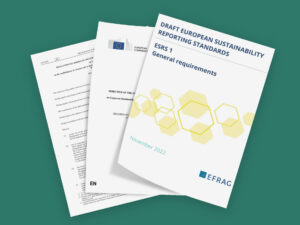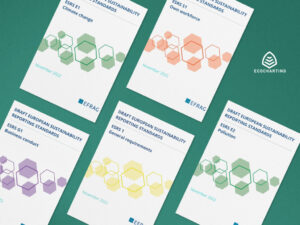In order to remain future-proof, organizations will have to take rapid steps in the field of sustainability management and digitization. The moment to start building on your ESG data platform is now. A major challenge, because this has not been a major focus for many organizations so far. However, this is now changing: the new European legislation (CSRD) that obliges organizations to report on sustainability offers an important incentive to really get started now.
Fortunately, more and more organizations are also intrinsically driven to take action in the field of sustainability. Good thing too, as the recent IPCC report shows. The results underline that short-term action is required to create a viable future for all. The CSRD obligation means that large organizations must be transparent in what they do and how they improve it.
To enable reliable sustainability reporting, a green data foundation is needed in which the organization can record and access reliable and up-to-date data in the areas of the environment, social aspects and governance (ESG). Where do you start as an organization to set this up properly?
There are a number of important opportunities and challenges to get started with this now.
Start on time
It still seems a long way off: many organizations will have to start reporting in the 2025 financial year. However, there is a lot involved in preparing the report properly. The CSRD consists of hundreds of pages of guidelines. Finding out which elements are relevant to your organization therefore takes quite some time. As soon as you know what you’re going to report on, you’re obviously not there yet. Because where do you get the data from? Some data will already be available, but usually numbers are in many different systems or spreadsheets. To build a good system around this, you better start on time.

Look at the long term: Stay away from Excel sheets
It is tempting to resort to excel sheets: it works quickly, easily and is a widely available system. Often it is already used to record various data and you can take many steps with it in the short term. It is advisable to take a critical look at this for various reasons. For example, sustainability data must be audited every year by the accountant. It is therefore important to be able to demonstrate where the data comes from and what it represents.
This can be a challenge when data is processed in spreadsheets. You also have to refresh the data every year and display it in the same way – so you better set up a data infrastructure that is easy to maintain and refresh. Everyone, internal and external, such as the accountant, must know where the data comes from and how it is refreshed. An opportunity here is to automate data links as much as possible, so that the workload for reporting decreases every year. So invest in this from the start, in order to relieve your work in the longer term.
Share the burden
The hundreds of pages of guidelines are divided into various topics, from environmental, social issues to administrative matters. It is not realistic for most organizations to place all data collection under the responsibility of one person. Make use of each other’s expertise and distribute the workload based on the different departments in the organization. For example, the human resources department can embrace the social topics and the environmental topics can be placed with a sustainability manager. It is important to coordinate this well from a steering group with different disciplines.
Start small
A final tip is to start small. Check which data you already have in-house and which indicators you can initially record. It is useful to first do a baseline measurement: see where the difference lies between what you should report on and what you already have at the moment.
To determine which topics and indicators belong in your organization’s sustainability report, the double materiality analysis is crucial. Here you determine which topics matter from two perspectives; inside out and outside in.
This exercise must take place for almost 100 (sub)topics. Stakeholders must also be involved in this so that you arrive at a thorough list of topics. Make this analysis easy with Ecocharting: all sustainability topics are available on our online environment to easily determine the double materiality.
Need help? Do not hesitate to contact us or reach out for a demo!
Start CSRD Preparations today. Request a demo.
Get a personalized tour of our intuitive CSRD software. Request a demo right away.



